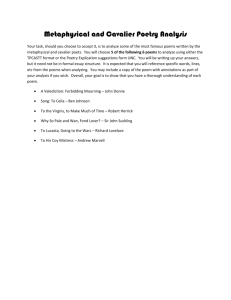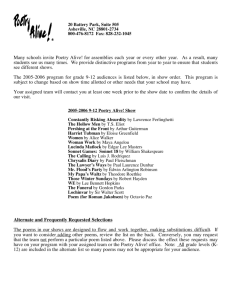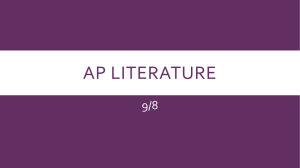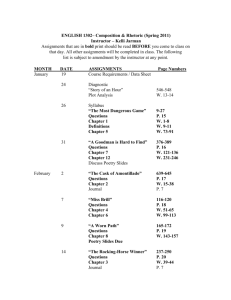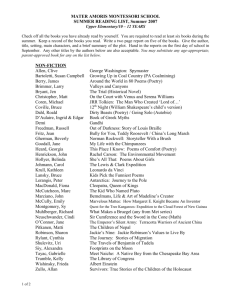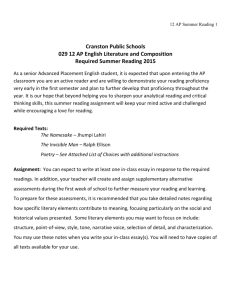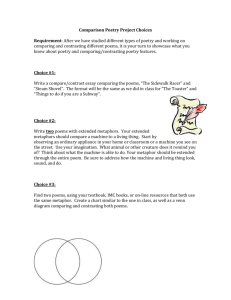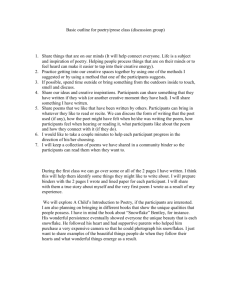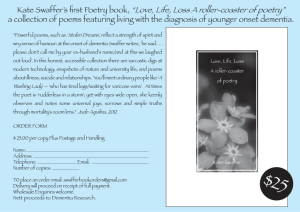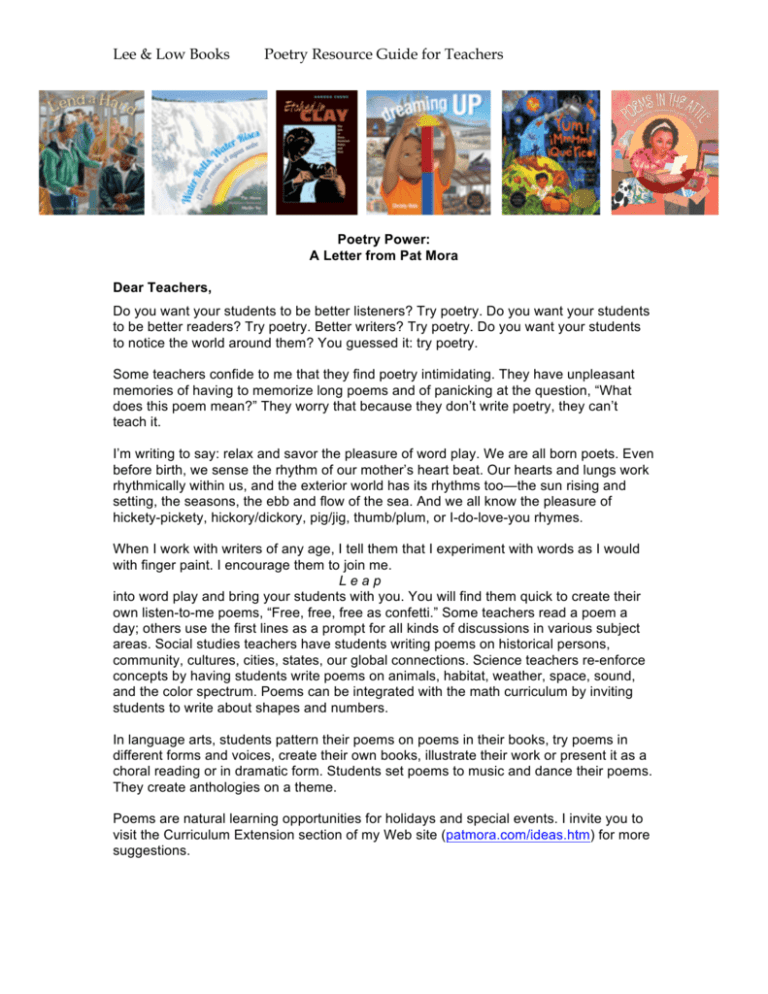
Lee & Low Books
Poetry Resource Guide for Teachers
Poetry Power:
A Letter from Pat Mora
Dear Teachers,
Do you want your students to be better listeners? Try poetry. Do you want your students
to be better readers? Try poetry. Better writers? Try poetry. Do you want your students
to notice the world around them? You guessed it: try poetry.
Some teachers confide to me that they find poetry intimidating. They have unpleasant
memories of having to memorize long poems and of panicking at the question, “What
does this poem mean?” They worry that because they don’t write poetry, they can’t
teach it.
I’m writing to say: relax and savor the pleasure of word play. We are all born poets. Even
before birth, we sense the rhythm of our mother’s heart beat. Our hearts and lungs work
rhythmically within us, and the exterior world has its rhythms too—the sun rising and
setting, the seasons, the ebb and flow of the sea. And we all know the pleasure of
hickety-pickety, hickory/dickory, pig/jig, thumb/plum, or I-do-love-you rhymes.
When I work with writers of any age, I tell them that I experiment with words as I would
with finger paint. I encourage them to join me.
Leap
into word play and bring your students with you. You will find them quick to create their
own listen-to-me poems, “Free, free, free as confetti.” Some teachers read a poem a
day; others use the first lines as a prompt for all kinds of discussions in various subject
areas. Social studies teachers have students writing poems on historical persons,
community, cultures, cities, states, our global connections. Science teachers re-enforce
concepts by having students write poems on animals, habitat, weather, space, sound,
and the color spectrum. Poems can be integrated with the math curriculum by inviting
students to write about shapes and numbers.
In language arts, students pattern their poems on poems in their books, try poems in
different forms and voices, create their own books, illustrate their work or present it as a
choral reading or in dramatic form. Students set poems to music and dance their poems.
They create anthologies on a theme.
Poems are natural learning opportunities for holidays and special events. I invite you to
visit the Curriculum Extension section of my Web site (patmora.com/ideas.htm) for more
suggestions.
Lee & Low Books
Poetry Resource Guide for Teachers
2
Students tell me they like to write poems because they can express their feelings. How
grand that they’re discovering that aspect of language. Teachers, too, often write along
with their students, discovering that poetry is a source of reflection and experimentation.
Add z-i-n-g to your learning day: explore the power of poetry.
Pat Mora
http://www.patmora.com
Here are some ideas to help you and your students get involved with reading and writing
poetry. Sources with additional information and guidance are listed at the end of this
guide.
Reading Poetry with Students
The best way to get students interested in writing poetry is first to spend time reading
poetry together and helping students become familiar with poetry as a way of expressing
feelings and ideas.
1. Make the reading of poetry part of your classroom routine and try reading a different
poem a day or the same poem every day for a week or two. Read your favorite
poems or students’ favorite poems. Read poems about different subjects and
celebrations. After hearing a variety of poems, students will begin to recognize what
different kinds of poetry sound like and they will begin to understand what makes a
poem a poem.
2. Invite students to talk freely about what they experienced during the poetry readings.
You may guide students with questions such as these:
• How did the poem(s) make you feel? What parts of the poem(s) made you feel
that way?
• How do you show what you are feeling or thinking about?
• Discuss features of the poem(s)—repetition, rhythm, sound, rhyme (if it is a
rhyming poem), imagery, humor, ambiguity, unusual words, unusual use of
words, and so on.
• What do you think makes a poem a poem?
• How are poems different from stories?
• Do you think poems are easier or harder to understand than stories? Why?
3. Invite students to look through poetry anthologies with you. Browse through several
anthologies, holding up various pages so students can see that poems vary in length
and physical shape and contain poems by many different writers. Once students
have started writing their own poems, they can create a class anthology, complete
with illustrations and bound into book format.
4. Organize a poetry center in the classroom, which is available for students to use
throughout the year. Place your favorite books of poetry in the center, and
encourage students to bring in their favorite poetry books too. Add books borrowed
from the school library, rotating the selections on a regular basis. Try to include some
books of poetry written by children, and be sure to include many books with freeverse, non-rhyming poetry, because this kind of poetry will be much easier for
students to write on their own.
Lee & Low Books
Poetry Resource Guide for Teachers
3
Helping Students Write Poetry
1. Talk with students to find out what they know and think about poetry. You might
brainstorm with students and record on the chalkboard or chart paper their thoughts
about what they like and do not like about writing poetry.
2. Discuss what was recorded. The number one dislike most students will probably
have is that poetry is hard to write because the words have to rhyme. However, most
poems written and published are free-verse poems without definite rhyme or
rhythmic patterns, so students should feel free to write non-rhyming poems as well
as rhyming ones. Released from the constraints of rhyme, many students find it
easier to focus on content and language and have fun with form.
3. Tell students they can write poems about anything they want, and it is often easiest
to begin by writing about something they feel strongly about or with which they are
very familiar. Poems can be about a person, a place, an action, a feeling, a thing, or
anything students care about. Their poems can tell about things exactly as they are,
or they can write from their imaginations. Also remind students that there are many
different kinds of poems—short poems, long poems, rhyming poems, non-rhyming
poems, poems that repeat the same words several times, poems that use made-up
words, poems in special shapes, and so on.
4. A poem cannot begin to take shape until students start putting words on paper, so
encourage them to begin writing even though they may not have the entire poem
worked out in their minds. Have students write down a first word, phrase, thought, or
sentence and then build on that by writing more words, phrases, thoughts, or
sentences. The joy of writing poetry is seeing where it takes you. Tell students to
write their ideas as fast as they come, and soon they will have the beginnings of a
first draft.
5. If students need more structured help getting started, you might suggest they try
writing biopoems. They can begin with their names and then go on to describe
themselves, their families, where they live, what they like to do, how they feel, where
they would like to go, and so on.
Here is an example:
Kim
Tall and hungry
Lives in Cloverdale
Wants to eat lunch
Made by Mom
Soon!
Another way for students to write biopoems is to answer the following questions.
Students’ responses may be words, phrases, complete sentences, or a combination.
It’s the expression of thoughts, ideas, and feelings in written form that will form the
basis of their poems.
For example:
Who? (the subject of the poem)
What? (what happened)
Where? (where it happened)
When? (when it happened)
Why? (why it happened)
Lee & Low Books
Poetry Resource Guide for Teachers
4
Biopoems are fun to write, but students should then be encouraged to write poems
about other topics—about anything at all really, that appeals to them.
6. After students have a first draft of their poems, they need to decide whether or not
they are satisfied with their poems as they are, or if they want to build, change, or
otherwise revise their work. Students can try reading their poems aloud at this stage,
to see where more (or less) is needed. Students may need to be reminded that they
don’t always have to include everything—sometimes the words might say too much.
Encourage students to edit their poems so that only the words that relate directly to
the feeling, subject, or mood of the poem remain. Be sure to give students plenty of
time to perfect their poems.
7. After the editing process, encourage students to share their work. A folder can be
used to keep copies of students’ poems, and near the end of the year, each student
may select her or his best poem to include in an illustrated class anthology. You
might also work with students to plan a poetry party to celebrate students’ work.
Invite other classes or parents and caregivers, and have students read their poems
to the group.
Lee & Low Books of Poetry
Lee & Low Books offers an award-winning selection of diverse poetry for children. Be
sure to share these books with your students as you embark on a journey of poetic
discovery.
A Full Moon is Rising (https://www.leeandlow.com/books/2741)
written by Marilyn Singer, illustrated by Julia Cairns
A collection of original poems about full moon events, phenomena, celebrations,
and beliefs from around the world.
Amazing Faces (https://www.leeandlow.com/books/2713)
by Lee Hopkins, illustrated by Chris Soentpiet
An anthology of universal poems focusing on the human experience—emotions,
perceptions, and understandings—as expressed by poets of diverse heritage and
reflected in illustrations featuring people of all ages and backgrounds.
Angels Ride Bikes and Other Fall Poems / Los Ángeles Andan en Bicicleta y otros
poemas de otoñ (https://www.leeandlow.com/books/2788)
written by Francisco X. Alarcón, illustrated by Maya Christina Gonzalez
Following the success of their award-winning book of spring poems,Laughing
Tomatoes, and their acclaimed collection of summer poems,From the Bellybutton of the
Moon, poet Francisco Alarcón and artist Maya Christina Gonzalez invite us to
experience fall in Los Angeles-the City of Angels-where dreams can come true.
Animal Poems of the Iguazú / Animalario del Iguazú
(https://www.leeandlow.com/books/2844)
written by Francisco X. Alarcón, illustrated by Maya Christina Gonzalez
Spanning three countries—Argentina, Brazil, and Paraguay—the thundering
waterfalls and lush green rainforests of the Iguazú have dazzled visitors for centuries,
and are now in danger of being lost. Following the Amerindian oral tradition, awardwinning Chicano poet Francisco X. Alarcón lets the animals of the Iguazú speak for
Lee & Low Books
Poetry Resource Guide for Teachers
5
themselves in their own soaring, roaring, fluttering voices, and the resulting poems are
as urgent as they are beautiful and humorous.
Chess Rumble (https://www.leeandlow.com/books/2374)
written by G. Neri, illustrated by Jesse Joshua Watson
A story in free verse about a troubled boy who learns to use his mind instead of
his fists through the guidance of an unconventional mentor and the game of chess.
Children of Long Ago (https://www.leeandlow.com/books/2375)
written by Lessie Jones Little, illustrated by Jan Spivey Gilchrist, introduction by Eloise
Greenfield
A celebration of African American childhood in the early 1900s, as told through
poems that detail the daily pleasures of young children’s lives.
Confetti: Poems for Children (https://www.leeandlow.com/books/2378)
written by Pat Mora, illustrated by Enrique O. Sanchez
The culture and landscape of the Southwest is celebrated in poetry through the
eyes of a Mexican American girl.
Cool Melons—Turn to Frogs! The Life and Poems of Issa
(https://www.leeandlow.com/books/2379)
written and translated by Matthew Gollub, illustrated by Kazuko G. Stone
An introduction to Haiku and the life if Issa, Japan’s premier haiku poet, told
through narrative, art, and translations of Issa's poems.
DeShawn Days (https://www.leeandlow.com/books/2383)
written by Tony Medina, illustrated by R. Gregory Christie
A story in verse about the hopes, fears, and dreams of a young boy living in the
inner city projects.
Dreaming Up: A Celebration of Building (https://www.leeandlow.com/books/2814)
written and illustrated by Christy Hale
A collection of illustrations, concrete poetry, and photographs that shows how
young children’s constructions, created as they play, are reflected in notable works of
architecture from around the world.
Etched in Clay: The Life of Dave, Enslaved Potter and Poet
(https://www.leeandlow.com/books/2815)
written and illustrated by Andrea Cheng
The story of the life and times of Dave, an enslaved potter who inscribed his
works with sayings and short poems in spite of the slave anti-literacy sentiment in South
Carolina in the years leading up to the Civil War. Middle grade/young adult biography in
verse.
From the Bellybutton of the Moon and Other Summer Poems/Del ombligo de la
luna y otros poemas de verano (https://www.leeandlow.com/books/2789)
written by Francisco X. Alarcón, illustrated by Maya Christina Gonzalez
In this fresh collection of 22 bilingual poems, renowned poet Francisco X.
Alarcón shares his touching recollections of childhood summers in Mexico.
Lee & Low Books
Poetry Resource Guide for Teachers
6
Gracias ~ Thanks (https://www.leeandlow.com/books/2711)
written by Pat Mora, illustrated by John Parra
In a series of poetic sentences, a young biracial boy tells about some of the
everyday things for which he is thankful.
How We Are Smart (https://www.leeandlow.com/books/2406)
written by W. Nikola-Lisa, illustrated by Sean Qualls
Biographies of twelve talented people introduce readers to the eight ways people
can be smart and the realization that intelligence is “not about how smart you are, but
how you are smart.”
I and I Bob Marley (https://www.leeandlow.com/books/2702)
written by Tony Medina, illustrated by Jesse Joshua Watson
A biography in verse of reggae legend Bob Marley, exploring the influences that
shaped his life and music on his journey from rural Jamaican childhood to international
superstardom.
Iguanas in the Snow and Other Winter Poems/ Iguanas en la nieve y otros poemas
de invierno (https://www.leeandlow.com/books/2793)
written by Francisco X. Alarcón, illustrated by Maya Christina Gonzalez
In their final collection of seasonal poetry, poet Francisco X. Alarcón and artist
Maya Christina Gonzalez invite us to celebrate winter—by the seashore, in the magic
city of San Francisco, and in the ancient redwood forests of the Sierras.
In Daddy’s Arms I Am Tall: African Americans Celebrating Fathers
(https://www.leeandlow.com/books/2408)
written by various poets, illustrated by Javaka Steptoe
Twelve African American poets give testimony to the powerful bond between
fathers, children, and grandchildren.
Laughing Tomatoes and Other Spring Poems/ Jitomates Risueños y otros poemas
de primavera (https://www.leeandlow.com/books/2786)
written by Francisco X. Alarcón, illustrated by Maya Christina Gonzalez
From the imagination of poet Francisco X. Alarcón comes Laughing Tomatoes
and Other Spring Poems, a playful and moving collection of twenty poems in English
and Spanish. With joy and tenderness, delight and sadness, Alcarcón's poems honor the
wonders of life and nature.
Lend a Hand: Poems About Giving (https://www.leeandlow.com/books/2849)
written by John Frank, illustrated by London Ladd
A collection of original poems centered on giving and spontaneous acts of
kindness, which also incorporate larger themes of community, intergenerational
relationships, young mentors, and care for the environment.
Love to Langston (https://www.leeandlow.com/books/2423)
written by Tony Medina, illustrated by R. Gregory Christie
Fourteen original poems offer young readers an exciting glimpse into the life of
Langston Hughes, one of America's most beloved poets. Each of Medina's engaging
poems explores an important theme in Hughes' life — his lonely childhood, his love of
language and travel, his dream of writing poetry.
Lee & Low Books
Poetry Resource Guide for Teachers
7
Love to Mamá: A Tribute to Mothers (https://www.leeandlow.com/books/2424)
edited by Pat Mora, illustrated by Paula S. Barragán
Thirteen Latino poets celebrate their bonds with their mothers and grandmothers.
Poems in the Attic (https://www.leeandlow.com/books/2881)
written by Nikki Grimes, illustrated by Elizabeth Zunon
A young girl grows closer to her mother after discovering a box of poems her
mother wrote about her experiences living around the world and growing up as a child of
an Air Force serviceman. Told in alternating free verse and tanka poems.
Poems to Dream Together/Poemas para soñar juntos
(https://www.leeandlow.com/books/2433)
written by Francisco X. Alarcón, illustrated by Paula Barragán
A bilingual collection of poetry by acclaimed Chicano poet Francisco X. Alarcón
celebrating family, community, nature, and the positive power of dreams to shape our
future.
Shanghai Messenger (https://www.leeandlow.com/books/2449)
written by Andrea Cheng, illustrated by Ed Young
A story in verse of a biracial Chinese American girl’s journey to self-discovery
and love of family as she visits her extended family in Shanghai, China. For middle
grade readers.
Summoning the Phoenix: Poems and Prose About Chinese Musical Instruments
(https://www.leeandlow.com/books/2841)
written by Emily Jiang, illustrated by April Chu
A collection of original poems about children learning to play traditional Chinese
instruments in preparation for a performance, accompanied by factual information about
each instrument.
Tan to Tamarind: Poems About the Color Brown
(https://www.leeandlow.com/books/2784)
written by Malathi Iyengar, illustrated by Jamel Akib
This warm and inviting poetry collection helps young readers discover that no
matter what your skin tone, every shade is beautiful.
The Palm of My Heart: Poetry by African American Children
(https://www.leeandlow.com/books/2430)
edited by Davida Adedjouma, illustrated by R. Gregory Christie, introduction by Lucille
Clifton
African American children celebrate the beauty of their lives and culture through
poetry.
The Pot That Juan Built (https://www.leeandlow.com/books/2434)
written by Nancy Andrews-Goebel, illustrated by David Diaz
The story of Juan Quezada and his journey from discovering ancient methods of making
pottery to becoming the premier potter in Mexico.
Tofu Quilt (https://www.leeandlow.com/books/2710)
written by Ching Yeung Russell
Lee & Low Books
Poetry Resource Guide for Teachers
8
A collection of poems telling the story of Yeung Ying, a young girl in Hong Kong
in the 1960s who, against the conventions of society and family members, aspires to
become a writer
Under the Mesquite (https://www.leeandlow.com/books/2723)
written by Guadalupe Garcia McCall
Lupita, a budding actor and poet in a close-knit Mexican American immigrant
family, comes of age as she struggles with adult responsibilities during her mother's long
illness. Young adult novel in verse.
Water Rolls, Water Rises/ El agua rueda, el agua sube
(https://www.leeandlow.com/books/2865)
written by Pat Mora, illustrated by Meilo So
In a series of poetic verses in English and Spanish, readers learn about the
movement and moods of water around the world and the ways in which water affects
varied landscapes and cultures.
When the Horses Ride By: Children in the Times of War
(https://www.leeandlow.com/books/2473)
written by Eloise Greenfield, illustrated by Jan Gilchrist
A collection of poems about children throughout history, focusing on their
perceptions of war and how war affects their lives.
Yum! ¡MmMm! ¡Qué rico! Americas' Sproutings
(https://www.leeandlow.com/books/2477)
written by Pat Mora, illustrated by Rafael Lopez
A collection of haiku focusing on fourteen foods native to the Americas,
celebrating the fun of the foods as well as their origins.
Sources with More Ideas for Teaching Poetry
BOOKS
Beech, Linda, and Merrily P. Hansen, editors. Instant Activities for Poetry That Kids
Really Love! New York: Scholastic, 1997.
Cullinan, Bernice E., and David Harrison. Easy Poetry Lessons that Dazzle and Delight.
New York: Scholastic, 1999.
Fehler, Gene. Let the Poems Begin: A Poet’s Guide to Writing Poetry. Greensboro, NC:
Good Apple, 2000.
Heard, Georgia. Awakening the Heart: Exploring Poetry in Elementary and Middle
School. Portsmouth, NH: Heinemann, 1998.
Heard, Georgia. For the Good of the Earth and Sun: Teaching Poetry. Portsmouth, NH:
Heinemann, 1989.
Janeczko, Paul B. Favorite Poetry Lessons. New York: Scholastic, 1998.
Janeczko, Paul B. How to Write Poetry. New York: Scholastic, 1999.
Routman, Regie. Kids’ Poems series by Regie Routman. New York: Scholastic, 2000.
Sweeney, Jacqueline. Teaching Poetry: Yes You Can! New York: Scholastic, 1995.
WEBSITES
Pat Mora’s website:
http://www.patmora.com
Lee & Low Books
Poetry Resource Guide for Teachers
El día de los niños/El día de los libros (Children's Day/Book Day)
http://dia.ala.org/
PoetryTeachers:
http://www.poetryteachers.com
TeacherVision:
https://www.teachervision.com
Lee & Low Books:
https://www.leeandlow.com/educators
ReadWriteThink:
http://www.readwritethink.org
ShareMyLesson:
http://www.sharemylesson.com
Edsitement:
http://edsitement.neh.gov
RESOURCES ON THE WEB:
Learn more about Lee & Low Books at: https://www.leeandlow.com
ORDER INFORMATION
On the Web:
https://www.leeandlow.com/contact/ordering (general order information)
By Phone: 212-779-4400 ext. 25
By Fax: 212-683-1894 fax
By Mail: Lee & Low Books, 95 Madison Avenue, NY, NY 10016
Copyright © 2015 The Active Learner,
Lee & Low Books. All rights reserved.
For questions, comments, and/or more information,
please contact us at general@leeandlow.com
9

